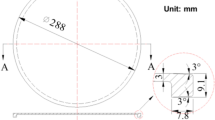Abstract
Spinning thickening is a novel metal-bulk forming technology for sheet metal, which gains successful applications in the net-shape manufacture of the structural parts with thin web plates and thick rims in automobile industry. However, through-process design of the forming scheme considering the possible variation of relative position of the plate is still lacking. To this end, the instantaneous stress-strain distribution of the plate, the bending force of the plate, and the order of the metal filling into roller groove were analyzed. Additionally, forming quality of the Eigen-structure with different spinning gaps was studied and quantitatively evaluated by experiments and FE simulation. It is found that pit, flash, hump, and depression are the dominant forming defects that influence the surface quality and performance of the parts. With the increase of positive spinning gaps, the area of the pit increases firstly and then decreases. With the increase of the absolute value of negative spinning gaps, the area of the pit increases continuously. By employing weighting method, a new index is proposed to evaluate the combined forming quality of the Eigen-structure. In addition, a phenomenological model was established for characterizing the correlation between the spinning gap and the quality index. Finally, taking the variation of spinning gap into consideration, process optimization of a two-step spinning thickening process was carried out under the constraint of multiple defects. The optimized range of spinning gap was obtained and experimentally validated. Results show that the quality of thick rim is improved by utilizing the optimized scheme and the target parts were formed with high quality under the reasonable range of spinning gap.
Similar content being viewed by others
References
Erman Tekkay A, Ben Khalifa N, Grzancic G, Hölker R (2014) Forming of lightweight metal components: need for new technologies. Procedia Eng 81:28–37. https://doi.org/10.1016/j.proeng.2014.09.125
Kleiner M, Geiger M, Klaus A (2003) Manufacturing of lightweight components by metal forming. CIRP Ann Manuf Technol 52:521–542. https://doi.org/10.1016/S0007-8506(07)60202-9
Kermanpur A, Mahmoudi S, Hajipour A (2008) Numerical simulation of metal flow and solidification in the multi-cavity casting moulds of automotive components. J Mater Process Technol 206:62–68. https://doi.org/10.1016/j.jmatprotec.2007.12.004
Godefroid LB, Faria GL, Cândido LC, Araujo SC (2014) Fatigue failure of a welded automotive component. Procedia Mater Sci 3:1902–1907. https://doi.org/10.1016/j.mspro.2014.06.307
Jin JS, Wang XY, Deng L, Luo JC (2016) A single-step hot stamping-forging process for aluminum alloy shell parts with nonuniform thickness. J Mater Process Technol 228:170–178. https://doi.org/10.1016/j.jmatprotec.2015.07.009
Xia QX, Xiao GF, Long H, Cheng XQ, Sheng XF (2014) A review of process advancement of novel metal spinning. Int J Mach Tool Manu 85:100–121. https://doi.org/10.1016/j.ijmachtools.2014.05.005
Wong CC, Dean TA, Lin J (2003) A review of spinning, shear spinning and flowing spinning processes. Int J Mach Tool Manu 43:1419–1435. https://doi.org/10.1016/S0890-6955(03)00172-X
Music O, Allwood JM, Kawai K (2010) A review of the mechanics of metal spinning. J Mater Process Technol 210:3–23. https://doi.org/10.1016/j.jmatprotec.2009.08.021
Merklein M, Behrens BA, Brosius A, Hagenah H, Kuzman K, Mori K, Tekkaya AE, Weckenmann A (2012) Bulk forming of sheet metal. CIRP Ann Manuf Technol 61:725–745. https://doi.org/10.1016/j.cirp.2012.05.007
Merklein M, Koch J, Opel S, Schneider T (2011) Fundamental investigations on the material flow at combined sheet and bulk metal forming process. CIRP Ann Manuf Technol 60:283–286. https://doi.org/10.1016/j.cirp.2011.03.146
Huang L, Yang H, Zhan M, Hu LJ (2008) Numerical simulation of influence of material parameters on splitting spinning of aluminum alloy. Trans Nonferrous Metals Soc China 18:674–681
Huang L, Yang H, Zhan M, Hu LJ (2009) Forming characteristics of splitting spinning based on the behaviors of roller. Comput Mater Sci 45:449–461
Wang XY, Li L, Deng L, Jin JS, Hu YZ (2015) Effect of forming parameters on sheet metal stability during a rotary forming process for rim thickening. J Mater Process Technol 223:262–273. https://doi.org/10.1016/j.jmatprotec.2015.04.009
Jin JS, Deng L, Wang XY, Xia JC (2012) A new rotary forming process for rim thickening of disc-like sheet metal part. J Mater Process Technol 212:2247–2254. https://doi.org/10.1016/j.jmatprotec.2012.06.013
Wang XY, Jin JS, Hu YZ, Deng L, Li JJ (2017) Study on the rotary forming process of a rim-thickened disc-like part using a local heating method. Int J Mech Sci 131-132:252–264. https://doi.org/10.1016/j.ijmecsci.2017.06.056
Wang CH, Liu KZ, Zhou L (2017) Spinning technology. Fujian, pp:715–716 (in Chinese)
Wang ZB, Fang XW, He WK, Song ZL (1994) The mechanical properties of engineering materials data handbook. Beijing, pp:338–339 (in Chinese)
Xue KM, Gong ZTZ, Li P, Chen Q (2013) Forming method of the part with thin web plate and thick rim. Chinese Patent: 201310421324.8
Acknowledgements
The authors would like to gratefully acknowledge the support of National Natural Science Foundation of China (51575153) and Science and Technology Program of Jiangsu Province, China (BA2016047). The authors gratefully extend their acknowledgement to Nantong Fuleda Vehicle Accessory Component Co, Ltd., for manufacturing the equipment.
Author information
Authors and Affiliations
Corresponding author
Rights and permissions
About this article
Cite this article
Xue, K., Yang, W., Yan, S. et al. Forming defect control and optimization of multi-step spinning thickening process considering the variation of spinning gap. Int J Adv Manuf Technol 101, 1183–1196 (2019). https://doi.org/10.1007/s00170-018-2960-3
Received:
Accepted:
Published:
Issue Date:
DOI: https://doi.org/10.1007/s00170-018-2960-3




